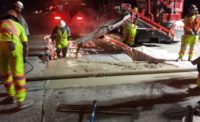Concrete created by two University of Nebraska professors can be heated to melt snow and ice without chemicals or mechanical clearing. Acceptance has been slow since it was developed and successfully demonstrated on a Nebraska highway bridge several years ago, but it has been used on a parking garage’s ramps in China, and the Federal Aviation Administration now is evaluating it for possible use on an airport in the northern U.S.
The recipe sounds simple: Mix steel fibers, steel shavings and carbon particles into regular concrete to make it electrically conductive, says the co-creator, Christopher Tuan. “You hook up the concrete to a power source, and the current going through will heat up the concrete. The heat propagates to the surface, preventing the ice formation,” he notes.
 Tuan, professor of civil engineering, and Lin Nguyen, professor of computer engineering, developed the concrete in a research project funded, from 1997 to 2002, by the Nebraska Dept. of Roads. It was demonstrated on a bridge in Roca, Neb., 15 miles south of Lincoln, and monitored until 2008. The NDOR report concluded, “Performance has been satisfactory and consistent for the past five years. The average energy cost was about $250 per snowstorm. Conductive concrete has the potential to become a very cost-effective bridge-deck deicing method.”
Tuan, professor of civil engineering, and Lin Nguyen, professor of computer engineering, developed the concrete in a research project funded, from 1997 to 2002, by the Nebraska Dept. of Roads. It was demonstrated on a bridge in Roca, Neb., 15 miles south of Lincoln, and monitored until 2008. The NDOR report concluded, “Performance has been satisfactory and consistent for the past five years. The average energy cost was about $250 per snowstorm. Conductive concrete has the potential to become a very cost-effective bridge-deck deicing method.”
The demo occurred on a 150- ft-long, 36-ft-wide, three-span highway bridge. NDOR designed the bridge, and Christensen Brothers Inc., Cherokee, Iowa, built it with a 10.5-in.-thick regular reinforced-concrete deck, leaving a 4-in.-deep void for the conductive concrete, Tuan says. The deicing mix contains 1.5% steel fibers and 15% carbon powder by volume.
Pairs of angle irons, positioned 3.5 ft apart, were embedded for the electrodes, with threaded sleeves welded to one end to make an electrical connection. When the electrodes were energized, the conductive materials in the concrete transmitted the current, turning the entire deck into a heating element. The operating cost for the bridge is 8¢ per sq ft.
The conductive concrete costs $300 per cu yd, compared with $120 for regular concrete, but “there’s no maintenance cost to speak of,” Tuan says. Maintaining the Roca bridge during five years of monitoring, for example, cost $230 to repair epoxy coating dinged by a snow plow.
Despite the positive conclusion of the report, NDOR has not used conductive concrete elsewhere, in part because of the cost of the software required for automatic operation of the system, says Wallace Heyen, NDOR portland-cement concrete engineer. “However, with today’s technology, the automation of the deicing system has been resolved,” he adds. “Due to the workability of the concrete during construction of the bridge deck, the bridge deck had smoothness issues,” requiring diamond-grinding and exposing the metal pins, which then rusted, he says. Rust penetrated only the top quarter-inch, but NDOR sealed the spalled areas to prevent further deterioration.
Tuan calls conductive concrete “a mature technology” and says he now has an FAA project, for which he has reduced the unit price by 60%. “We did the Roca bridge with top-of-the-line materials, so it was very expensive,” he says. “If they like the results, they’ll let me do a mock tarmac at the tech center in Atlantic City.”
Implementation of Conductive Concrete for Deicing (Roca Bridge) PDF





Post a comment to this article
Report Abusive Comment